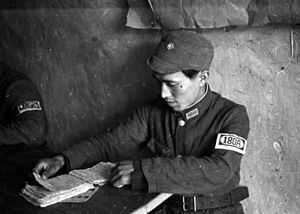Japanese People's Emancipation League

The Japanese People's Emancipation League (JPEL) or Emancipation League, was a Japanese resistance organization that operated in communist China during the Second Sino-Japanese War, and World War II.[1]
Founding
In 1944, the Japanese People's Emancipation League was established in Yanan at the suggestion of Sanzo Nosaka. It was made up of converted Japanese POWs.[1] Mao Zedong, Zhu De, Nosaka Sanzo (under the name Okano Susumu,) and other CCP leaders participated in the inaugural assembly of the JPEL. Zhu De called the foundation of the JPEL the starting point of a new Chinese-Japanese relationship, predicting that when the JPEL's struggle resulted in the establishment of a "people's government" in Japan, China and Japan would then become "genuinely cordial and reciprocal friends."[2]
League principles
The Emancipation League had a three-point program: "opposition to the war, the overthrow of the militarists, and the establishment of a democratic, people's government in postwar Japan.". The Emancipation League was designed primarily to influence the character of Japan's postwar development. The Emancipation League was open to communists, non-communists, and anti-communists. What was required for membership was "agreement with the basic program advocating the end of the war, the overthrow of the militarists and the establishment of a democratic Japan with improved conditions for peasants, industiral laborers and small business men.".[1]
Estimated number of members
A Life magazine article in December 18, 1944, titled "Inside Red China From remote, inaccessible Yenan comes an account of Communist resistance against merciless Japanese by Teddy White" reported that the Japanese People's Emancipation League had numbered more than 300 active members.[3]
See also
- Japanese in the Chinese resistance to the Empire of Japan
- Japanese dissidence during the Shōwa period
- League to Raise the Political Consciousness of Japanese Troops
- National Committee for a Free Germany